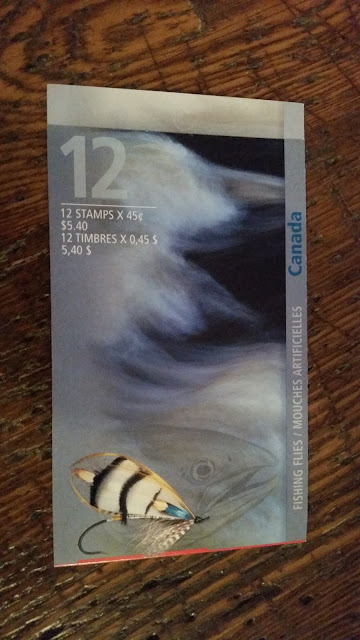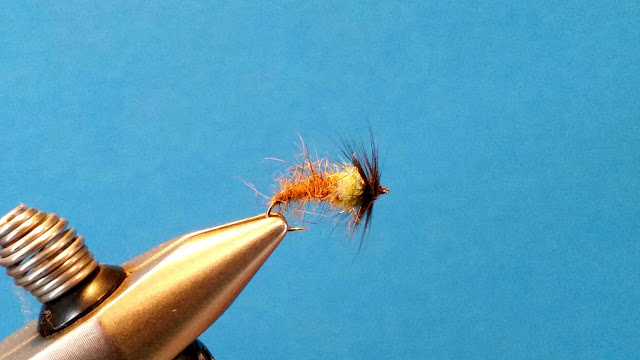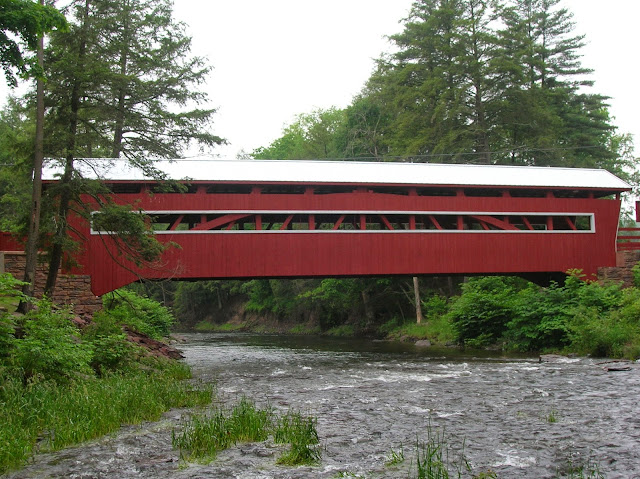Monday, February 27, 2017
Saturday, February 25, 2017
Topwater in February
My rewards.....2 dozen or so just like this one to a #10 Foam Butt Caddis.
Once the sun came up high I noticed fish chasing and switched to a black woolybugger....and found 1/4 pounders that barely let the fly move before taking. Nothing of size, but fun none-the-less.
1st fish on top for the year.....in February. And a day on the water with the CGR.
No complaints.
Saturday, February 18, 2017
Building a Pond Box
Building a Pond Box
In many instances, we stock our warmwater boxes with piles of 2/0 hooked poppers, leeches and bunny flies, looking for that elusive bucket-mouth. Haunting the big water, or the most likely waters to produce a bass that will stress the hook on your pocket scale. Only to move on after a few non-productive trips, looking for better water. Or better yet, we will drive past countless suburban ponds and catch basins with nobody on them, on our way to crowded waters to fight jet skis and bass boats.All the while carrying the mindset of "bass or nothing" when it comes to warmwater fishing. Ironically, I was that guy for many years. That is, until I discovered a few jewels hidden in plain sight. Since realizing the attributes I needed to look for in water, most of my fishing takes place on small stalkable or wadeable ponds. Those waters are filled predominantly with 1/2 pounders and dink bass.....but bluegills that flip the cards.
Catch Basins or flood control ponds on small suburban creeks are prime targets. Look for water that is creek fed vs spring. Most catch basin ponds will be shallow enough to wade the edges, but it will need a creek channel to hold fish through low water and winter drainage. Take an evening and sit on the banks of a likely looking water. at dusk, the water will show you the fish if they are there. Ignore a lack of fishing pressure. Most are seldom fished. They don't stand out as bass water, so no interest is found. However, most yield the most impressive panfish in the area for two reasons.
Most fisherman disregard small water as "dink fisheries', and secondly, the folks who do know what a pond has to offer are throwing them back. There is little interest in eating out of water filled with road runoff. Which provides the perfect storm for huge gills. Farm ponds, development ponds and small bogs are all in need of a scouting trip. No matter how small or unassuming they first appear. Don't get me wrong, they can still hold some great bass. But if you gear up solely for those few fish, you will miss out on some of the best bluegill fishing you've ever inflated a float tube for.
Many of which you will fish an entire season and seldom if ever share the water with another fisherman. Does this all carry the ambiance of a wilderness trout stream? No, certainly not. But when you set the hook on a rising 10"-12" bluegill, that thought will suddenly escape you. Nothing fights quite like a large gill.
The Patterns
My Poppers
It's a basic deer hair bluegill popper. Go with whatever color they like the most on a given day. The MDD however pulls everything up. While I've tied it with countless color variations over the years, I've never seen a need to go with anything but natural. So I go with what the fish tell me. I prefer to fish poppers that will pull in bass, but won't exclude me from hooking the largest panfish as well. That way I

never have to choose what I need to gear up for.
Another pattern in my box is tied in the foam style of the Gartside Gurgler. These 3 patterns cover everything from solely bluegill days, to rolling takes in open water. and slapping a fly in and amongst the lily pad openings.

never have to choose what I need to gear up for.
The Gurglers
Another pattern in my box is tied in the foam style of the Gartside Gurgler. These 3 patterns cover everything from solely bluegill days, to rolling takes in open water. and slapping a fly in and amongst the lily pad openings.
The Gurgling Wog is tied to imitate the polliwogs often found swimming along the pond edges in the spring. Later in the summer as they grow, you will find them hanging along the underside off of the lily pads.
While the Wog is found on the edges and hanging with the lilies. The Gurgling Frog is my 1st choice when I have open expanses of water between to groups of pads.
The Mini Wog is extremely effective when cast to the bank and twitched retrieved. Filling the bluegill popper niche.
Both the Wog & Frog are capable of bringing to the surface the best of what a particular water has to offer.
Big Gills can't resist the Frog over open water.
The Foam Butt Caddis
If I had to choose a single pattern for any warmwater haunt I was about to fish.....it would be the Foam Butt Caddis. It brings anything that see's it to the surface. From early spring to late fall, it is the fly of choice nine times out of ten. It's at home on the edges, or in the lily pads. Tied larger than the original cricket pattern and on a stinger hook, it is the one fly I am never out of.
It has a way of pulling the largest gills out of the crowd. whether twitch retrieved or pulled under, this fly remains effective.
Bass are equally drawn to it. And when skittered, they will often chase it, slashing as they go.
Did I say big gills love this fly?
The Wet Side
I love staying on top fishing warm water. But I enjoy catching fish better than getting skunked. Not all days are a surface fly day. Here are the patterns I tie and carry.
The Little Crappie Fly
That in a nutshell is my warmwater box. I am constantly tweaking and adjusting, but the patterns listed here are constants in my box. Give them a try. Let me know how they do for you on your home waters.
For tying videos on all the patterns referenced, please click on the link below:
Thursday, February 16, 2017
Tying the Mini Wog
 |
The Mini Wog |
The Mini Wog is a pattern based on the Gurgling Wog, tied smaller in panfish popper fashion. Tied and fished late last summer, the pattern did well for itself. This season I am anticipating that, and much more over the spring spawning beds.
Mini Wog Recipe
Hook: #8 Gamakatsu Stinger
Thread: Black Danville 210
Tail: Dyed black pheasant tail
Hackle: Tan Brahma Hen
Abdomen: Black Wooly Bugger Chenille
Shell: Black Razor Foam
Legs: Tan-barred Centipede legs
Post: Flo Orange Antron Yarn
Wednesday, February 15, 2017
The Mystique of Atlantic Salmon Flies
Classic Salmon Flies
What is it about Atlantic Salmon flies that draw us in? Is it the history or the brilliance of the artwork? Having tied, fished and caught a handful of steelhead and salmon in the Pacific Northwest on a few of the classics, the attraction is palpable. Walk in a fly tying expo and its nearly impossible to not stop when passing a finely tied Atlantic Salmon fly.
I was gifted these stamps 19 years ago after SwapMastering a Salmon benefit swap. It has remained one of my cherished possessions ever since.
I keep telling myself that one day I will tie a matching fly for each and frame them. But I fear I could never do them justice. It is an art that I am envious of.
Yet each time I pull them out, to admire them, I can sit back and feel the current against my line as it swings.
Monday, February 13, 2017
Tying the Cased Caddis
Tuesday, February 7, 2017
The Telling of Waters
I stood looking upstream at the old covered bridge, pondering how many memories it had cast a shadow upon over the years. This was water I knew well having fished it so many times as a youth, and I took some time to watch as the sun began to dip below the tree line which would soon bring cooler air to the summer day. I had just fished downstream for a short while in an effort to catch an evening hatch, while my youngest son swam with his cousins in the upstream riffles. And as expected the water had given up a handful of trout in which I was able to bring to hand. How many times had I spent a summer evening cooling off in those same waters as a child? It was countless in number. Yet I watched as another generation took my place. The covered bridge was a landmark in the area, and being a short jump over the mountain from home, it was often a way to beat the heat for the locals. There was no park area then. No playground for the kids. It was a gravel beach near a large pool, an old cast iron charcoal grill on a cemented pipe and a couple wooden picnic tables. But for us, it was better than any resort imagined. I recalled swimming just as my son was while my Dad would fish below the bridge. Often, he would bring back a few trout for the grill before the day ended. We would cook them in aluminum foil and sit in the chilling air, picking the meat off the bones with a damp towel draped over our shoulders for warmth, as our wet cut-off jeans puddled on the wooden bench.
Soon after however, I was fishing alongside my dad during those outings with the family. The trout waters got their hooks in me at an early age. No doubt much earlier than my Dad probably had wished for however, since my presence often curtailed much of his fishing as well. His days on the water quickly became tutoring and watching over me as I plodded along, knotting lines and losing rigs, yet I don’t recall him ever showing any frustration with me on the water. What I do recall are memories of watching a mallard hen leading 10 ducklings along the bank then around my hip-boots like I never even existed, as I stood there with rod in hand, wide-eyed in amazement. I remember watching my Dad hook and land the largest brook trout I have seen caught to date beneath that covered bridge. And I can still smell the aroma of venison burgers grilling over briquettes. Such a welcome smell of smoke as the day drew to a close and my Dad and I walked back together to the family picnic site. Where like always, my brother and sister could be found drying off from their swim above the bridge.
Little did I know what those memories along that rural Pennsylvania creek held in store for me as time moved on. The seeds in which my Dad had planted would not only grow into a lifelong love of waters, but it would also show me what those waters have to say…if you listen close.
Subscribe to:
Posts (Atom)































